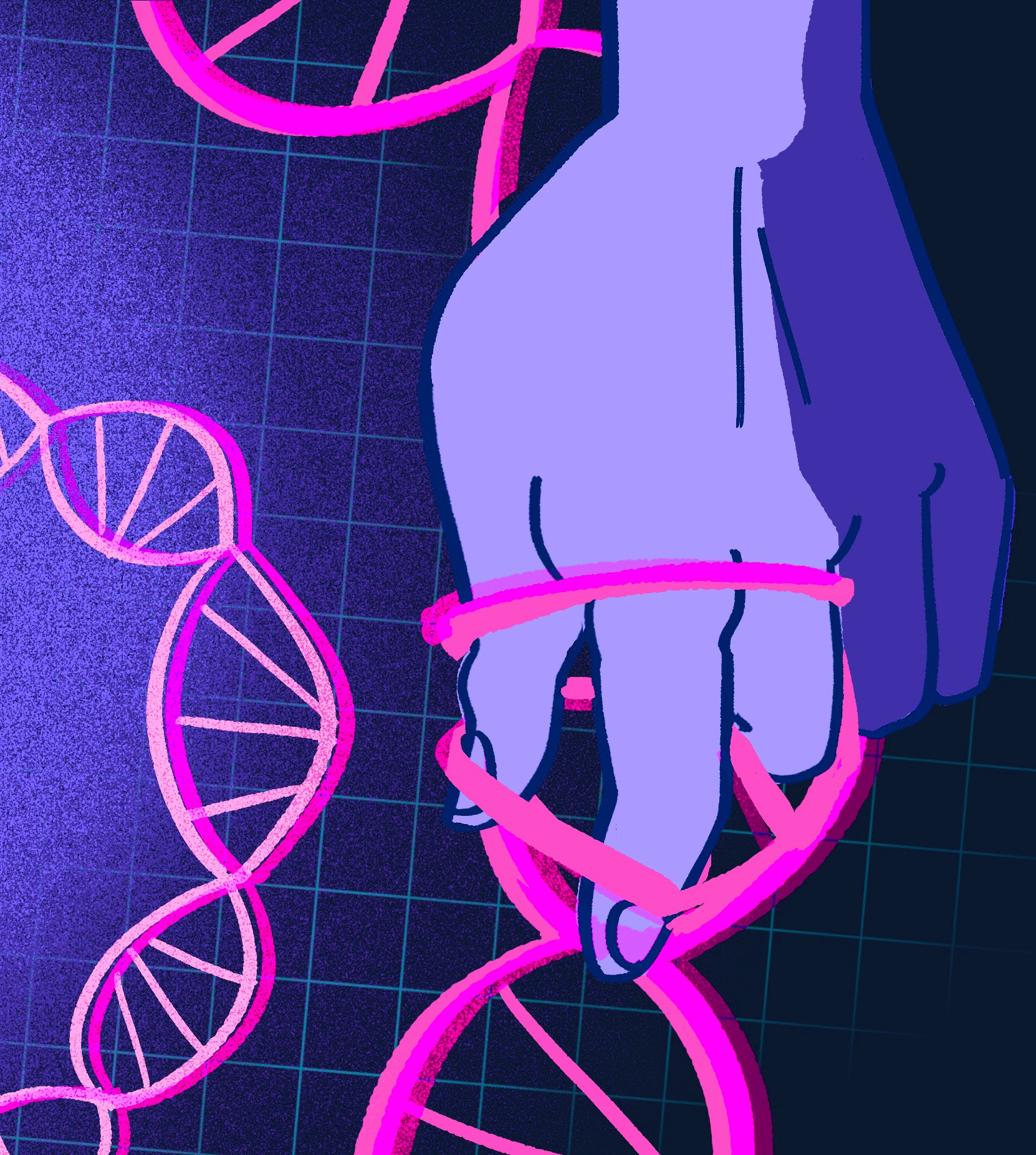
Eugenics is Back: In a range of new flavors
By Anne Rumberger and Marcy Darnovsky
Volume 26, no. 1, Gender: Beyond Binaries
Eugenics is widely regarded as a debunked pseudoscience—developed and promoted mostly in Nazi Germany—that fell off the political radar after the horrors of the Holocaust were revealed. In fact, twentieth century eugenics represented the mainstream science of its day and was championed by prominent figures and popular movements across the political spectrum in countries around the world. Despite widespread post-war condemnation of Nazi eugenics and striking advances in scientific understanding of genetics, eugenics never disappeared.
Today, new strains of eugenic ideas and practices are appearing in surprisingly divergent ideological, policy, and technological arenas. On the right, some wield eugenics as an accusation against liberals; others promote worldviews directly imported from the eugenic playbook. In the first category, abortion opponents and politicians claim that, in the words of Supreme Court Justice Clarence Thomas, abortion is akin to “eugenic manipulation.” In the second, white supremacists are promoting the “Great Replacement Theory,” which postulates a deliberate project by liberal elites (often under Jewish guidance) to replace white populations with more Democratic-leaning and higher birth rate non-white populations.
Eugenic ideas are also re-emerging elsewhere. Influencers among the Silicon Valley techno-libertarian elite are embracing pronatalism and new reproductive technologies with which they anticipate being able to engineer their own children to be genetically superior. Some scientists are critical of the repro-genetic technologies that underlie these efforts, but others are enthusiastically supporting the development and marketing of reproductive gene editing, “polygenic risk scores” to rank IVF embryos on traits including “educational attainment,” and related techniques that raise concerns about a new eugenics.1
Why does all this matter? Eugenic assumptions that some groups of people are biologically superior to others and eugenic temptations to “improve” the human condition through reproductive interventions stand to undermine the possibility of achieving social justice through social changes. Reviving eugenic ideas and beliefs will justify already obscene levels of inequality; exacerbate racism, discrimination against people with disabilities, and anti-immigrant sentiments; and strengthen attempts by both the state and the market to control and stratify reproduction. Challenging these resurgent eugenic ideas and understanding the current politics of reproduction are prerequisites for imagining and building an alternative future.
Eugenics and the politics of abortion
In his April 2023 ruling aiming to suspend the FDA’s approval of the abortion drug mifepristone, the Texas-based federal judge Matthew Kacsmaryk cited Justice Clarence Thomas’s efforts to link abortion to eugenics.2 Thomas devoted over a dozen pages to this theme in his 2019 opinion on the Supreme Court’s decision about two abortion laws. He warned of “the potential for abortion to become a tool of eugenic manipulation” and argued that “the use of abortion to achieve eugenic goals is not merely hypothetical.”3 He harked back to the Supreme Court’s upholding the constitutionality of Virginia’s forced-sterilization law in Buck v. Bell in 1927, which many consider one of the Court’s worst mistakes.4 He reflected that “[t]echnological advances have only heightened the eugenic potential for abortion, as abortion can now be used to eliminate children with unwanted characteristics, such as a particular sex or disability.”5
Thomas’s strained attempt to claim the moral high ground with warnings against eugenics weaponizes the continued prevalence of eugenic practices and beliefs. It also builds on decades of work by abortion opponents. Their claim that many pregnancies are terminated for sex selection or to prevent the birth of children with disabilities has motivated the passage of “reason-based” or “trait-selection” abortion bans in seventeen states. Despite their lofty rhetoric, their goal has always been clear. As explained in 2021 by Michael Stokes Paulsen, an anti-abortion law professor long involved with the Federalist Society, these reason-based restrictions aimed “to lay the groundwork for (or to attain straightaway) the overruling of Roe and Casey, by attacking their constitutional reasoning in a particularly sympathetic and persuasive context that lays bare where their logic leads.”6 If the hypocrisy here was ever in doubt, it was amply confirmed when, in the months after the Dobbs decision overturned Roe v. Wade, fourteen of those states sought to ban all abortions at six weeks—too early to determine fetal sex or other traits.
Further, anti-abortion advocates typically have no problem with state efforts to control reproduction based on racist and bigoted ideas. This is not just a historical phenomenon of forced sterilization under explicitly eugenic laws; recent and current practices also bespeak eugenic intentions. The debate over welfare policy in the 1990s was deeply racialized and some conservative lawmakers tried to control the birth rate of single mothers, particularly Black single mothers, through the Aid to Families with Dependent Children (AFDC) program.7 They introduced family caps, which denied incremental increases to benefits for families after they had a certain number of children. One Department of Health and Human Services official spoke in favor of family cap policies by saying that the government should not reward “irresponsible” behavior.
Anti-abortion forces manage to manipulate eugenic ideas and profess concern about racial equity in order to further their agenda.
Some states devised other ways to limit the reproduction of mothers receiving welfare benefits, such as proposing bills to pay mothers on AFDC who agreed to have the long-acting reversible contraceptive device Norplant implanted in their arms, or requiring women to use Norplant as a condition of receiving AFDC. Many health professionals in the 1990s also targeted and pressured Black mothers, especially Black teen mothers receiving Medicaid or AFDC, to use Norplant. In a 1990 editorial in the Philadelphia Inquirer, Norplant was suggested as a way to control the Black birth rate and thus reduce poverty.8 In 2017 a judge in Tennessee permitted inmates to have their sentences reduced by thirty days in exchange for men undergoing vasectomies, or women receiving a long-acting birth control implant. “I hope to encourage them to take personal responsibility and give them a chance, when they do get out, not to be burdened with children,” Judge Benningfield told a local news outlet.9. And in 2020, whistleblowers alleged that dozens of immigrants held in an ICE detention facility in Georgia were sterilized without their consent or pressured to have unnecessary hysterectomies.10
Despite these realities, anti-abortion forces manage to manipulate eugenic ideas and profess concern about racial equity in order to further their agenda. This is in part because historically white-led reproductive rights organizations have, until recently, been hesitant to confront harms motivated by eugenics, past and present, and the role of leaders including Margaret Sanger in that history. As acclaimed author and activist Dorothy Roberts made clear in her response to Clarence Thomas’s Dobbs concurrence linking abortion rights with racism, “It’s a false retelling of history because abortion was not an instrument of eugenicists; sterilization was. Abortion is a means of reproductive freedom. Whereas coerced sterilization is a means of population control.” Because the mainstream abortion rights movement was largely unaware of and uninterested in the concerns of working-class women of color, outside of small left organizations, the fight for abortion access was disconnected from struggles against forced sterilization and racist welfare policies. Roberts points out that “If reproductive justice were at the forefront from the very beginning, there is no way today people would accept Clarence Thomas’s argument. It would be blatantly ridiculous.”11
In addition to grappling with the eugenic and racist affiliations of historical feminist figures, today’s abortion rights activists can confront the hypocrisy of the anti-abortion campaigners by acknowledging that eugenic ideas are a real and present threat to people with disabilities. Especially given the horrific toll taken by past eugenic practices on the disability community, today’s practices of sex selection and disability de-selection present complex ethical dilemmas. Many disability rights activists have long coupled support for abortion rights with campaigns to combat ableist assumptions in decisions about pregnancy termination. They are fully aware that legislators and anti-abortion leaders are co-opting disability rights language to justify reason-based abortion bans, and that these restrictions do nothing to advance disability rights or to remedy concerns about stigmatization and discrimination.12
“While it’s true that we must interrogate the ableism that leads to many disabled fetuses being aborted, disabled folks are not to be used as props to support harmful pro-life politics. We are not your pro-life scapegoats and eugenics has no place in abortion access,” says disability rights activist Stefanie Lyn Kaufman-Mthimkhulu.13 And as George Washington University Law School professor Sonia M. Suter puts it, the right-wing “legislative focus on eugenics is largely performative, rather than evidence of true concern about the discrimination and disparities underlying eugenics.”14
Demographic panics and reproductive politics
Concerns about population control have long been mobilized in support of racist and discriminatory welfare and immigration policies. Today we’re hearing arguments contrary to those in Paul Ehrlich’s alarmist and bestselling book The Population Bomb from the late 1960s—warnings about plummeting population rather than about too many people—but reactionary elements of the demographic panic persist. The concern of the growing pronatalist movement is not about increasing the overall population, which adherents claim is necessary to ensure continued economic growth, but about having more of the “right” kids. The politics of these largely wealthy pronatalists might not align completely with those of right-wing demographic collapse fearmongers like Tucker Carlson, but there is an alarming amount of overlap. Eugenic ideas influence both the hand-wringing around falling birth rates and the overtly racist “Great Replacement” conspiracy theory pushed by Christian nationalists.
The narrative that falsely asserts an active effort to replace white populations with more Democratic-leaning non-white populations has been linked to many acts of racist violence, including the mass shootings at a grocery store in Buffalo, New York in 2022 and at a Walmart in El Paso, Texas in 2019. Tucker Carlson repeatedly used the phrase “great replacement” on air, portraying immigration at the Southern border and falling birth rates as existential threats to white people. Once a fringe conspiracy theory, this belief has gained some mainstream traction. According to a poll conducted by the Associated Press-NORC Center for Public Affairs Research in December 2021, roughly one in three adults agree that a group of people is trying to replace “native-born Americans” with immigrants for electoral gains. A similar share also expresses concern that an increase in immigration is leading to “native-born Americans” losing economic, political, and cultural influence.15
Right-wing Republicans and far-right leaders around the world are connecting anti-immigrant anxieties to nationalist fears of falling birth rates. In 2017 Iowa Republican congress member Steve King was criticized for tweeting “We can’t restore our civilization with somebody else’s babies” while defending the anti-immigrant statements of far-right Dutch candidate Geert Wilders. “You’ve got to keep your birth rate up, and…teach your children your values,” King said.16 In 2019 Hungary’s anti-immigration Prime Minister Viktor Orban said, “Instead of just numbers, we want Hungarian children. Migration for us is surrender.”17
Last May, after the leak of the Supreme Court’s Dobbs v. Jackson Women’s Health Organization decision which struck down the legal right to abortion, Matt Schlapp, the head of the influential Conservative Political Action Conference (CPAC), said that overturning Roe v. Wade would be a good “first step” in fixing what he says is the problem of immigration in the United States. “If you say there is a population problem in a country, but you’re killing millions of your own people through legalized abortion every year, if that were to be reduced, some of that problem is solved,” Schlapp said. “If you’re worried about this quote-unquote replacement, why don’t we start there? Start with allowing our own people to live.”18 And in June 2022, after the Dobbs decision was announced, Illinois Representative Mary Miller called the end of Roe a “historic victory for white life” at a rally with former President Donald Trump. Her spokesperson later said she had misspoken and meant to say “victory for right to life,” but her very clear remark was met with applause from the audience.19 The twisted logic that combines pro-life advocacy with fears of falling birth rates and shifting racial demographics is a potent weapon used by Christian nationalists to bolster support for their unpopular agenda.
The concern of the growing pronatalist movement is not about increasing the overall population […] but about having more of the ‘right’ kids.
Eugenics in Silicon Valley: Better babies for billionaires
A related manifestation of eugenic ideas, probably less familiar to most supporters of abortion rights, is emanating from today’s Silicon Valley techno-libertarian elite. Influential figures in that milieu, including Elon Musk, are embracing pronatalism for those in their circles and pouring money into new reproductive technologies including the production of artificial gametes. Some openly embrace transhumanism and support efforts to engineer genetically superior children.
The science behind twentieth-century eugenics may have been discredited decades ago, but today cutting-edge scientific developments are treading dangerously close to a new “techno-eugenics.” The prospect that wealthy parents will use CRISPR20 or other genome editing tools to “enhance” their offspring may be biologically dubious, but it’s likely to be commercially irresistible for the assisted reproduction sector, notoriously under-regulated in the United States.21 Start-ups like Genomic Prediction and Orchid are already offering to analyze IVF embryos using polygenic risk scores derived from proprietary algorithms applied to genome-wide association studies. The embryos are ranked according to their risks for health conditions, disability statuses, and even behavioral traits. Polygenic risk scores for “educational attainment” are openly discussed.22
A 2022 story in Business Insider reports on these trends in wealthy tech circles. The article centers on Simone and Malcolm Collins, self-identified pronatalists who calculate that as long as each of their descendants commits to having at least eight children for eleven generations, their bloodline will eventually dominate the human population. “We could set the future of our species,” says Malcolm.23 The Collinses support technologies like polygenic risk scoring as part of their mission. “It’s using the cutting edge of science to give your future children every advantage you can,” says Simone. “It’s giving kids a better roll of the dice.”24 On their pronatalism.org website, the Collinses note that “[b]irth rates are falling precipitously around the world in both developed and developing countries” and warn, “If dramatic action is not taken, we will witness the extinction of entire societies, expansion of totalitarian governments, and an unchecked rise of tribalism.”
For their own reproductive ventures, the Collinses patronized Genomic Prediction, a New Jersey-based genetic testing company founded in 2017 to test embryos for heart disease, five types of cancer, diabetes, and schizophrenia. They were also eager to test for so-called “mental-performance-adjacent traits,” including stress, chronically low mood, brain fog, mood swings, fatigue, anxiety, and ADHD. These tests are not offered by Genomic Prediction or a competitor, Orchid, but the Collinses were able to download their raw genetic data and use a DNA testing company called SelfDecode to get data on what they call “the fun stuff.” Simone revealed that two polygenic testing start-ups are planning to test for “the fun stuff” and were fundraising quietly because “they anticipate being essentially canceled as soon as they go public.”25
Some mainstream science organizations like the European Society of Human Genetics consider polygenic test scores for embryos to be unproven and unethical, and to pose serious societal risks.26 An article in Nature has warned that such testing could lead to needless discard of viable embryos or induce women to undergo repeated rounds of ovarian stimulation to collect larger numbers of eggs in order to create more choices among embryos.27 No clinical research protocol has been performed so far to assess the diagnostic effectiveness of polygenic risk scores in embryos, and as the organization’s Executive Committee stated in 2021, “it would take many years to obtain reliable results, given that one might have to wait decades for people to develop, for example, early-onset Alzheimer’s disease.”28 The plausibility of polygenic risk scores is also limited by racial biases in medical research: nearly all the genome-wide association studies they rely on are carried out in populations of European ancestry, so the resulting data may not be valid for other populations.29
We must heed the reproductive justice call to simultaneously stand against harmful abortion bans and demand support for parents to raise children in safe and healthy communities.
As a society, we’ve yet to discuss the ethical considerations of making these tests available, especially as start-ups begin to offer to select for behavioral traits. Without any debate or oversight, it’s easy to see how the practice could worsen discrimination and stigmatization of specific conditions. Even if this technology remains unproven, limited, and largely misunderstood, it could inspire parents and society to behave as if the children, who were carefully and expensively selected at the embryo stage, were in fact biologically superior. For the assisted reproduction industry, selecting “the best” IVF embryos—and, if it is permitted, editing IVF embryos to “improve” them—would open potentially massive new markets of people who are not medically or socially infertile, but who are willing to invest in the “best” offspring.30
Confronting the new eugenics
The shameful history of twentieth-century eugenics, championed across the political spectrum and by a broad popular movement at the time, has had lasting and continuing consequences. Eugenics today uses a different vocabulary: phrases including “racial hygiene,” “feeble-mindedness,” and “inferior stock” are no longer acceptable, but discriminatory assumptions about disability remain deeply ingrained. Twenty-first-century eugenics is driven less by state coercion, and more by politically diverse dynamics including market logics, race-based backlash, and resurgent xenophobia. And it relies on different tools—forced sterilization is less common while forced birth is quickly becoming more common; “Better Babies” contests at state fairs have given way to “designer baby” fantasies among the rich and influential.
Legal abortions fell by over six percent, or 32,260 total, in the six months following the Dobbs ruling, according to research released by the Society of Family Planning in April.31 To force tens of thousands of people to carry a pregnancy against their will is an unacceptable form of reproductive control; we must heed the reproductive justice call to simultaneously stand against harmful abortion bans and demand support for parents to raise children in safe and healthy communities. We cannot accept a world where only the wealthy can afford to raise children, and where the elite use reproductive technologies in efforts to justify their delusions of genetic superiority. We can show how the harms of eugenic ideas and practices connect the dots among a wide variety of social justice movements. We can link condemnation of past eugenic abuses to current and looming ideologies, technologies, and polices that partake of the same insidious logic. As we challenge the new iterations of eugenic beliefs and practices, we must imagine and build a world free of the myths of biological superiority and grounded in bodily autonomy and social justice.
—
Anne Rumberger is an activist with NYC for Abortion Rights and Chicago for Abortion Rights. Her writing on reproductive politics has appeared in Jacobin, Salvage, Lux, and Biopolitical Times.
Marcy Darnovsky, PhD, is Executive Director at the Center for Genetics and Society, a nonprofit organization based in the San Francisco Bay Area that works to bring perspectives grounded in social justice, human rights, and health equity to considerations of human genetic and assisted reproductive technologies. Her articles have appeared in scholarly and general-audience publications including The New York Times, The Guardian, Los Angeles Times, Wall Street Journal, Nature, and Trends in Biotechnology; she is co-editor of Beyond Bioethics: Toward a New Biopolitics (with Osagie K. Obasogie, University of California Press). She has appeared on dozens of television, radio, and online news shows; and has been cited in hundreds of news and magazine articles.
—
From the SftP Archives: “Science for the People has covered eugenics consistently since the start of the publication in 1979. As you can see in the archives: in 1984, Ruth Hubbard wrote “Fetal Rights and the New Eugenics”, where you can read more about the history of eugenics and right wing rhetoric about abortion, describing how “Hereditarianism provided an intellectual framework to locate the sources of economic and social inequality within people rather than in social institutions, while eugenics offered a program ofaction to get rid of such people.” In 1985, Shelley Minden wrote “Genetic Engineering and Human Embryos“, voicing concerns about how reproductive technologies could place limits on reproductive freedom and uphold patriarchal power. This concern is shared and extended by Rumberger & Darnovsky’s writing on techo-eugenics, or the practice of the wealthy individuals committed to propagating the practice of producing designer babies. And in 1977, Linda Gordon wrote “Birth Control and the Eugenicists“, which describes the history of birth control and Margaret Sanger’s connection to eugenicists.
Notes
- Kalina Kamenova and Hazar Haidar, “The First Baby Born After Polygenic Embryo Screening,” Voices in Bioethics 8 (April 2022), https://doi.org/10.52214/vib.v8i.9467; Françoise Baylis and Marcy Darnovsky, “Scientists Disagree About the Ethics and Governance of Human Germline Editing,” The Hastings Center, January 17, 2019, https://www.thehastingscenter.org/scientists-disagree-ethics-governance-human-germline-genome-editing/.
- Alliance for Hippocratic Medicine v. FDA, No. 23-10362 (5th Cir. 2023).
- Ariane de Vogue, “Why Clarence Thomas wrote over a dozen pages on eugenics,” CNN, May 28, 2019, https://www.cnn.com/2019/05/28/politics/clarence-thomas-eugenics-abortion/index.html.
- Buck v. Bell, 274 U.S. 200 (1927).
- Michael Stokes Paulsen, “Abortion as an Instrument of Eugenics,” Harvard Law Review 134 (May 2021), https://harvardlawreview.org/forum/vol-134/abortion-as-an-instrument-of-eugenics.
- Paulsen, “Abortion as an Instrument of Eugenics.”
- Ife Floyd et al., “TANF Policies Reflect Racist Legacy of Cash Assistance,” Center on Budget and Policy Priorities, August 4, 2021, https://www.cbpp.org/research/family-income-support/tanf-policies-reflect-racist-legacy-of-cash-assistance.
- Thomas B. Rosenstiel, “Paper’s Editorial Sparks Racial Uproar in Philadelphia,” Los Angeles Times, December 20, 1990, https://www.latimes.com/archives/la-xpm-1990-12-20-mn-9571-story.html.
- Eric Levenson, “Judge rebuked after offering reduced jail time in exchange for vasectomies,” CNN, November 21, 2017, https://www.cnn.com/2017/11/21/us/tn-judge-vasectomy-birth-control-reprimand-trnd/index.html.
- José Olivares and John Washington, “‘He Just Empties You All Out’: Whistleblower Reports High Number of Hysterectomies at Ice Detention Facility,” The Intercept, September 15 2020, https://theintercept.com/2020/09/15/hysterectomies-ice-irwin-whistleblower/.
- Irin Carmon, “Dorothy Roberts Tried to Warn Us,” New York Magazine, September 6, 2022, https://nymag.com/intelligencer/2022/09/dorothy-roberts-tried-to-warn-us.html.
- Judith Levine, “Disability and the Politics of Abortion,” Seven Days, September 9, 2015, https://www.sevendaysvt.com/vermont/disability-and-the-politics-of-abortion/Content?oid=2868452.
- Char Adams, “Disability rights groups are fighting for abortion access — and against ableism,” NBC News, July 21, 2022, https://www.nbcnews.com/news/us-news/disability-rights-groups-are-fighting-abortion-access-ableism-rcna38703.
- Sonia M Suter, “Why reason-based abortion bans are not a remedy against eugenics: an empirical study,” Journal of Law and the Biosciences, 10(1), (January 2023), https://doi.org/10.1093/jlb/lsac033.
- “Immigration Attitudes and Conspiratorial Thinkers,” The AP-NORC Center for Public Affairs Research, May 2022, https://apnorc.org/wp-content/uploads/2022/05/Immigration-Report_V15.pdf.
- Theodore Schleifer, “King doubles down on controversial ‘babies’ tweet,” CNN, March 14, 2017, https://www.cnn.com/2017/03/13/politics/steve-king-babies-tweet-cnntv/index.html.
- Shaun Walker, “‘Baby machines’: eastern Europe’s answer to depopulation,” The Guardian, March 4, 2020, https://www.theguardian.com/world/2020/mar/04/baby-bonuses-fit-the-nationalist-agenda-but-do-they-work.
- David Gilbert, “CPAC Head Promotes Abortion Ban to Stave Off ‘Great Replacement,’” VICE News, May 19, 2022, https://www.vice.com/en/article/qjb7ad/cpac-head-promotes-abortion-ban-to-stave-off-great-replacement.
- Becky Sullivan, “A GOP congresswoman said the end of Roe is a ‘historic victory for white life,’” NPR, June 26, 2022, https://www.npr.org/2022/06/26/1107710215/roe-overturned-mary-miller-historic-victory-for-white-life.
- Clustered Regularly Interspaced Short Palindromic Repeats.
- Debora L. Spar, “Fertility Industry Is a Wild West,” New York Times, September 13, 2011, https://www.nytimes.com/roomfordebate/2011/09/13/making-laws-about-making-babies/fertility-industry-is-a-wild-west; Michael Ollove, “Lightly regulated in vitro fertilization yields thousands of babies annually,” Washington Post, April 13, 2015, https://www.washingtonpost.com/national/health-science/lightly-regulated-in-vitro-fertilization-yields-thousands-of-babies-annually/2015/04/13/f1f3fa36-d8a2-11e4-8103-fa84725dbf9d_story.html.
- Antonio Regalado, “Americans are ready to test embryos for future college chances, survey shows,” MIT Technology Review, February 9, 2023, https://www.technologyreview.com/2023/02/09/1068209/americans-test-embryos-college-chances-survey/; Philip Ball, “Polygenic screening of embryos is here, but is it ethical?,” The Guardian, October 17, 2021, https://www.theguardian.com/science/2021/oct/17/polygenic-screening-of-embryos-is-here-but-is-it-ethical.
- Julia Black, “Billionaires like Elon Musk want to save civilization by having tons of genetically superior kids. Inside the movement to take ‘control of human evolution,’” Business Insider, November 17, 2022, https://www.businessinsider.com/pronatalism-elon-musk-simone-malcolm-collins-underpopulation-breeding-tech-2022-11.
- Carey Goldberg, “The Pandora’s Box of Embryo Testing Is Officially Open,” Bloomberg, May 26, 2022, https://www.bloomberg.com/news/features/2022-05-26/dna-testing-for-embryos-promises-to-predict-genetic-diseases.
- Black, “Billionaires.”
- Francesca Forzano et al., “The use of polygenic risk scores in pre-implantation genetic testing: an unproven, unethical practice,” European Journal of Human Genetics 30, no. 5 (2022), https://doi.org/10.1038/s41431-021-01000-x.
- Kullo, I.J., Lewis, C.M., Inouye, M. et al., “Polygenic scores in biomedical research.” Nat Rev Genet 23, 524–532 (2022). https://doi.org/10.1038/s41576-022-00470-z.
- Forzano, “The use of polygenic risk scores.”
- Forzano, “The use of polygenic risk scores.”
- Henry T. Greely, The End of Sex and the Future of Human Reproduction, (Harvard University Press, 2016), 2-3.
- Society of Family Planning, “#WeCount Report,” April 11, 2023, https://doi.org/10.46621/143729dhcsyz.





